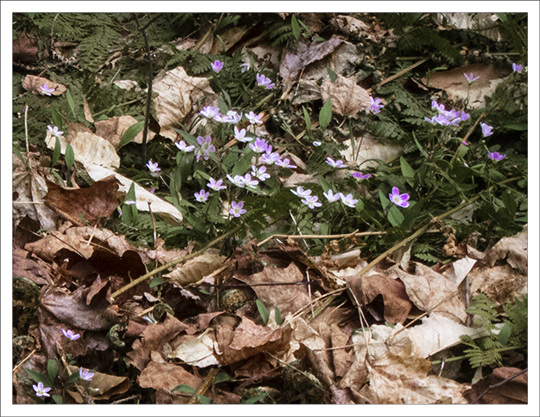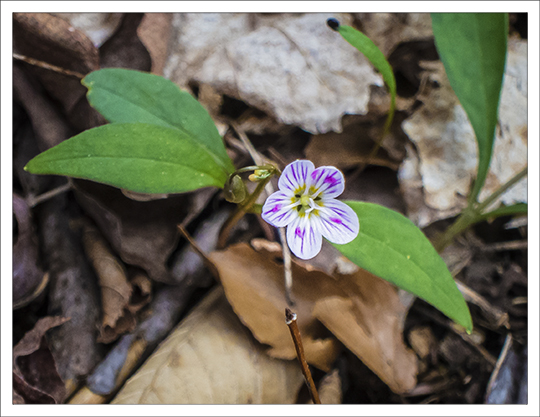Adirondack Wildflowers:
Carolina Springbeauty (Claytonia caroliniana)
 Adirondack Wildflowers: Carolina Springbeauty (Claytonia caroliniana) on the Heron Marsh Trail (8 May 2013)
Adirondack Wildflowers: Carolina Springbeauty (Claytonia caroliniana) on the Heron Marsh Trail (8 May 2013)
| This page is no longer being updated. For an updated and expanded version of this material, see: Carolina Spring Beauty (Claytonia caroliniana). |
Carolina Springbeauty (Claytonia caroliniana) is a woodland perennial that produces small flowers in spring. The petals are pink or white, with darker pink veins. Each flower is 3/4 inch wide. Each leaf is up to 3 inches long and about 3/4 inch wide. The plant is about 6 inches in height. The plant disappears from above the ground soon after the seed capsules have ripened. A similar plant, Claytonia virginica, has much narrower leaves.
Carolina Springbeauty is a member of the Purslane (Portulacaceae) family. The plant was named for John Clayton, who was Clerk to the County Court of Gloucester County, Virginia, from 1720 until his death in 1771. Clayton was one of the earliest collectors of plant specimens in that state. He has been described as the greatest American botanist of his day.
The root of this plant is said to be edible and can be eaten raw or cooked like potatoes. The roots reportedly have a pleasant nutty flavor. The leaves and stems apparently can also be eaten raw or cooked; they have a mild flavor. There are no known medicinal uses.
Carolina Springbeauty grows in shade or partial shade in rich soil in moist woods. It can be found in the eastern half of the US and Canada, including New York State.
 Adirondack Wildflowers: Carolina Springbeauty (Claytonia caroliniana) on the Heron Marsh Trail (8 May 2013)
Adirondack Wildflowers: Carolina Springbeauty (Claytonia caroliniana) on the Heron Marsh Trail (8 May 2013)
At the Paul Smiths VIC, Carolina Springbeauty may be seen along the Heron Marsh Trail. It usually blooms in this part of the Adirondack Park in early May, depending on the weather.
References
- Lady Bird Johnson Wildflower Center. Native Plant Database.
- United States Department of Agriculture. Plants Database.
- University of Michigan. Native American Ethnobotany. A Database of Foods, Drugs, Dyes and Fibers of Native American Peoples, Derived from Plants.
- NatureServe Explorer. Online Encyclopedia of Life.
- Plants for a Future. Database.
- University of Wisconsin. Robert W. Freckmann Herbarium.
- Connecticut Wildflowers. Wildflower Guide.
- New York Flora Association. New York Flora Atlas.
- ENature. Wildflower Field Guide.
- Doug Ladd. North Woods Wildflowers (Falcon Publishing, 2001), p. 93.
- Lawrence Newcomb. Newcomb's Wildflower Guide (Little Brown and Company, 1977), pp. 270-271.
- Roger Tory Peterson and Margaret McKenny. A Field Guide to Wildflowers. Northeastern and North-central North America (Houghton Mifflin Company, 1968) pp. 238-239.
- National Audubon Society. Field Guide to Wildflowers. Eastern Region. (Alfred A. Knopf, 2001), pp. 707-708.
- William K. Chapman, et al. Wildflowers of New York in Color (Syracuse University Press, 1998), pp. 20-21.
- Anne McGrath. Wildflowers of the Adirondacks (EarthWords, 1981, 2000), p. 26, Plate 13.
